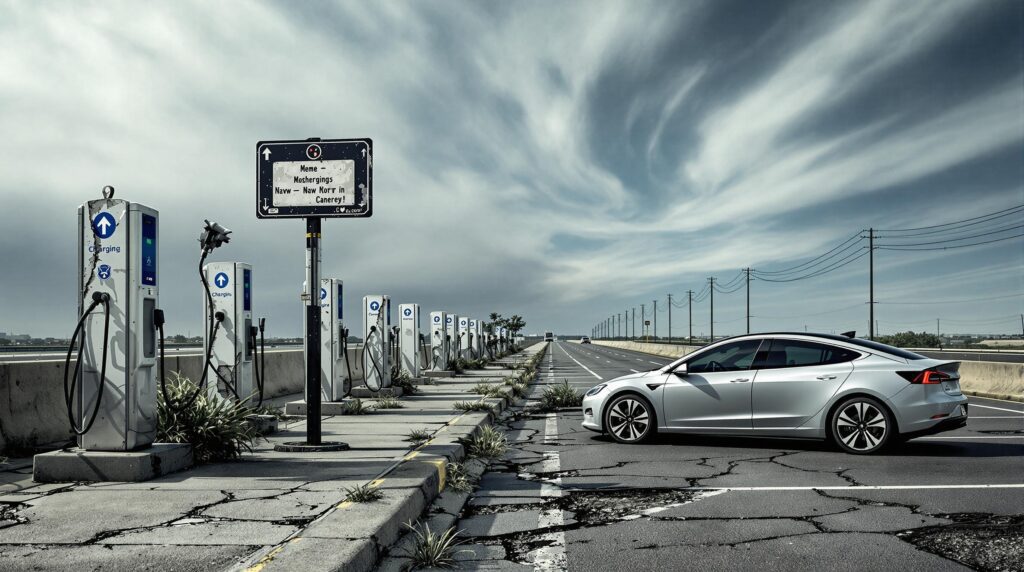Imagine living where your daily commute involves constant vigilance, weaving around potholes deep enough to echo inside nearby homes—this is Timothy Taylor’s everyday reality in Oregon. His troubles symbolize a broader issue facing states across the U.S.: as electric vehicles (EVs) grow more popular, traditional gas taxes that fund essential road repairs falter, leaving communities at risk and policy-makers scrambling. This isn’t merely a localized inconvenience; it’s indicative of broader sustainability challenges states now face.
The Hidden Cost of Progress
Advocates rightly tout the beneficial impact of EVs—cleaner air, reduced dependence on fossil fuels, and a healthier future. But the success story of electric vehicles comes with an often-overlooked subplot: dwindling revenues from gas taxes—a cornerstone of infrastructure budgets. The National Association of State Budget Officers (NASBO) highlights an unsettling trend: gas tax contributions have significantly dropped, accounting for just 36% of transportation funding in fiscal year 2024, down from 41% in 2016. This downward slide is troubling, punctuated by California’s alarming prediction of a staggering $5 billion budget shortfall by 2035 due to decreased fuel tax revenue. Zero-emission cars certainly help clear smoggy skies, but at what cost if roads deteriorate beneath our wheels?
Such fiscal woes force states to face tough choices that impact day-to-day services. In Oregon, the shortfall means potentially dire cutbacks; authorities are already bracing for a $350 million deficit in their upcoming budget cycle—money crucial for snow removal, road paving, and employing up to 1,000 transportation workers. If not adequately addressed, declining road quality and compromised public safety loom large.
Unsustainable Financing in a Sustainable Future?
But can we truly blame the environmentally conscious for driving electric? Certainly not. The problem lies less in the personal choices individuals make, and more in outdated funding structures dependent on combustion engines. It’s a systemic flaw exposed by inevitable technological advances. Carra Sahler, director of the Green Energy Institute at Lewis & Clark Law School, poignantly captures the Catch-22 faced by policymakers:
“We now find ourselves in a position where we want to address fuel use and reduce reliance on internal combustion engines…but we need operational funds for roads used by EVs too.”
States have traditionally relied on a gas-based tax system that was straightforward, even elegant, in its simplicity—drive more, buy more gas, pay more tax. Now, with cars increasingly running on electrons rather than petrol, states find their purses shrinking at the very moment their infrastructure needs surge.
The solution, inevitably, must involve a comprehensive overhaul in how states fund transportation infrastructure. Already, 34 states have resorted to raising gas taxes since 2013 in a bid to plug fiscal potholes. But repeated hikes offer diminishing returns; further increases risk public backlash and disproportionately impact lower-income populations, who are already burdened with commuting costs.
Seeking Progressive and Equitable Alternatives
What might fairer solutions look like? One promising alternative is mileage-based user fees (MBUF), a system where drivers pay based on how far they drive—regardless of vehicle type. Unlike a traditional gas tax, MBUF accurately captures road usage by both electric and gas-powered cars. Oregon pioneered this approach with a voluntary program that charges motorists a modest fee per mile driven, providing a more equitable, stable revenue stream less reliant on fossil fuels.
But fairness isn’t automatic. Progressive policy advocates caution that mileage-based fees could disproportionately affect rural residents who tend to travel further and thus pay more. Adjustments accounting for income and geography could help ensure such systems remain socially equitable and practically sustainable.
Additionally, there’s the notion of enhancing registration fees for EVs to recognize their road use while still encouraging drivers towards clean energy. However, like mileage-based fees, these too must be crafted to avoid punitive measures deterring emissions-conscious consumers.
State leaders must also consider leveraging federal support, especially funds accessible through recent infrastructure initiatives by the Biden administration, emphasizing green energy investment and modern infrastructure rebuilding. Combining state and federal resources could substantially mitigate budgetary shortfalls and stimulate job creation focused on sustainable infrastructure development.
Ultimately, this funding challenge isn’t merely economic—it strikes at the heart of how we collectively decide to balance ecological responsibilities with necessary infrastructure upkeep. As electric vehicles reshape transportation landscapes, they highlight critical flaws in old revenue models. Progressive change demands innovative responses that foster equitable financial responsibility while aligning with environmental objectives. Achieving this balance ensures we sustain not just our roads and bridges, but our shared future as well.

